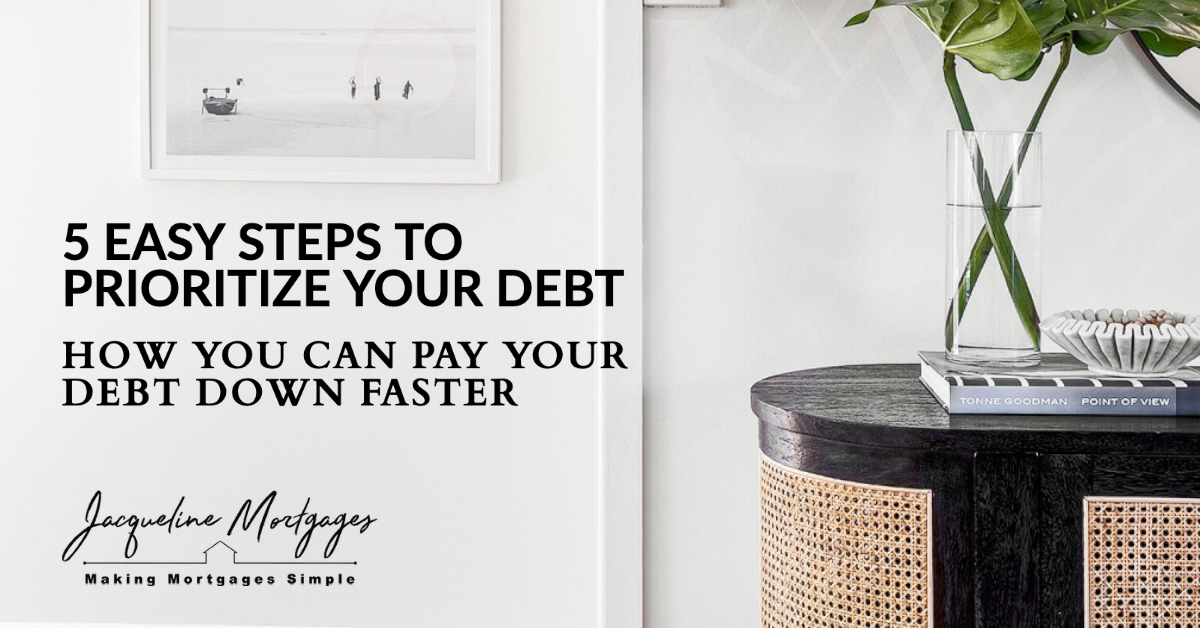
Is your debt controlling you or are you controlling your debt? If it is controlling you, then it is time to sit down and start prioritizing your debt. I have five steps that I have used personally and with my clients, to prioritize your debt to pay it down faster.
Step 1: List All of Your Debt
The first step to paying down your debt is to list everything you’re paying—credit cards, vehicle loans, lines of credits, personal loans, mortgages—whatever you have, write it down. I recommend doing so in a spreadsheet since we’ll be organizing it later on.
Step 2: Write Down the Balances, Interest Rates, and Minimum Payment Beside Each Debt
This follows along with Step 1 when you list your debts. Grab your statements and agreements to find this information.
Step 3: Organize by Highest Interest Rate
Once you have all the information written down, organize your debts in a spreadsheet. You can get the good ole’ piece of paper and draw columns too.
After writing everything down in your columns, you want to organize them from highest interest rate to lowest. You likely can see what is happening here…
| Debt | Interest Rate | Balance | Minimum Payment | Extra Payment |
| Visa | 19.99% | $5,000 | $98 | $645 |
| Mastercard | 19.99% | $7,000 | $150 | |
| Personal Loan | 7% | $6,000 | $297 | |
| Vehicle Loan | 3% | $15,000 | $460 | |
| Mortgage | 2.39% | $300,000 | $1,350 | |
| Total | $2,355 |
Step 4: Make a Budget
When you’re making your budget, ask yourself these three questions:
- What is your income coming in and what are your expenses (insurance, groceries, etc.)?
- Are you putting anything in for savings?
- What do you have to put towards debt and mortgage payments?
Be realistic when you are making your budget and look at about six months of previous spending habits. If you have consistently been spending more than you’re earning, curb those spending habits! Remember, this is a short-term solution to get your debt under control.
If you’re using your credit cards throughout the month, your balances will change. With your budget, you want to try and target those balances that are consistent each month.
Example: If you are spending $1,000/month on your card above the previous month’s balance, your budget should include that $1,000 being paid onto that card plus the minimum payment and extra payments. The minimum and extra payments are going to go towards bringing that existing balance down.
Step 5: Tackle the Highest Interest Rate Debt First
Now that you know your budget, it’s time to prioritize which debts to prioritize. For all of your debt listed, make sure you’re paying the minimum payments on all of them! This is going to help keep that consistent balance and maintain your credit score.
Next, start putting extra payments on the highest interest debt first and work your way down the list.
Example: You have $3,000/month to allocate towards debt repayment and mortgage payments. The total minimum payments equal $2,355/month, leaving $645/month towards extra payments.
Take the extra payment and put that on the Visa first. Once the Visa is paid off, you will have now $743/month to put on the Mastercard. Once Mastercard is paid off, you have an extra $893/month to put on the personal loan, etc.
And it’s really that simple! Most people are frozen when it comes to paying down their debt because they don’t know what they owe and to whom. Once you have everything laid out in front of you, you can quickly see where your attention needs to be, making the budgeting process easier.
There are of course other ways you can potentially use your mortgage to increase monthly cash flow to pay off your debt. If you have any questions about this, please give me a call! I’d love to help.
